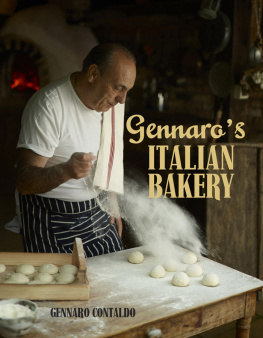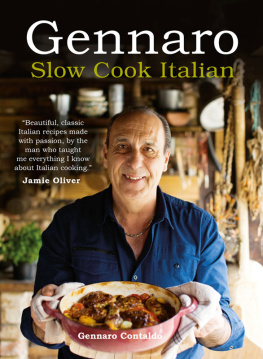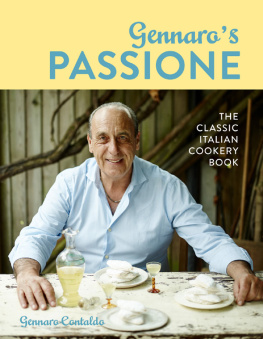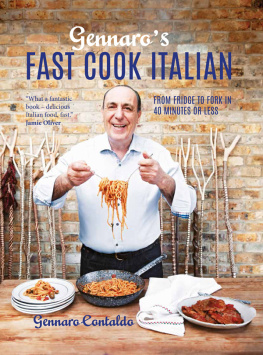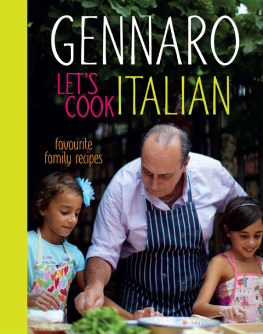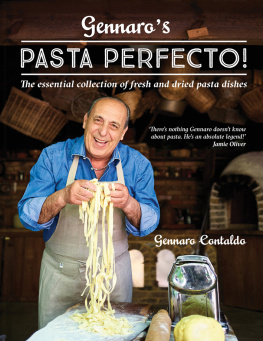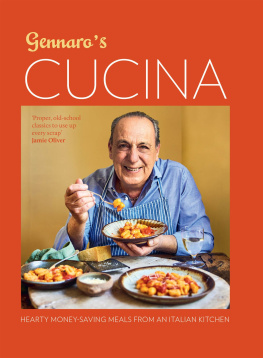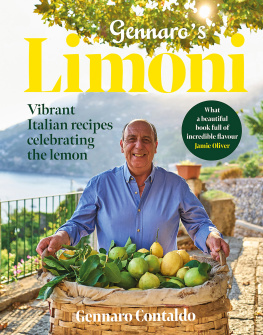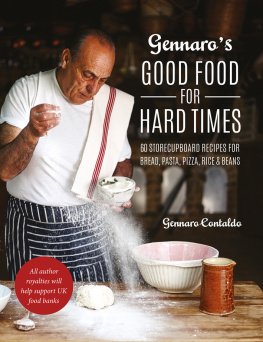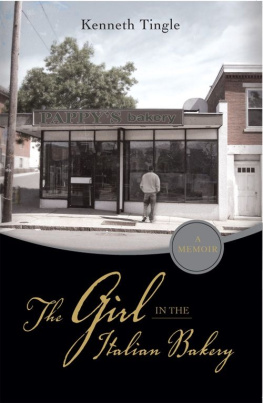Contaldo - Gennaros Italian Bakery
Here you can read online Contaldo - Gennaros Italian Bakery full text of the book (entire story) in english for free. Download pdf and epub, get meaning, cover and reviews about this ebook. year: 2016, publisher: Pavilion Books, genre: Home and family. Description of the work, (preface) as well as reviews are available. Best literature library LitArk.com created for fans of good reading and offers a wide selection of genres:
Romance novel
Science fiction
Adventure
Detective
Science
History
Home and family
Prose
Art
Politics
Computer
Non-fiction
Religion
Business
Children
Humor
Choose a favorite category and find really read worthwhile books. Enjoy immersion in the world of imagination, feel the emotions of the characters or learn something new for yourself, make an fascinating discovery.
- Book:Gennaros Italian Bakery
- Author:
- Publisher:Pavilion Books
- Genre:
- Year:2016
- Rating:5 / 5
- Favourites:Add to favourites
- Your mark:
- 100
- 1
- 2
- 3
- 4
- 5
Gennaros Italian Bakery: summary, description and annotation
We offer to read an annotation, description, summary or preface (depends on what the author of the book "Gennaros Italian Bakery" wrote himself). If you haven't found the necessary information about the book — write in the comments, we will try to find it.
Contaldo: author's other books
Who wrote Gennaros Italian Bakery? Find out the surname, the name of the author of the book and a list of all author's works by series.
Gennaros Italian Bakery — read online for free the complete book (whole text) full work
Below is the text of the book, divided by pages. System saving the place of the last page read, allows you to conveniently read the book "Gennaros Italian Bakery" online for free, without having to search again every time where you left off. Put a bookmark, and you can go to the page where you finished reading at any time.
Font size:
Interval:
Bookmark:




TO ADRIANA AND LIZ

When I first heard that my publisher was interested in doing a book about bread and baking, I was so excited! Baking, especially bread, has always been my passion in fact if my career hadnt gone down the route it has, I would have been a baker. Those three simple ingredients flour, yeast, water and what they are transformed into has always fascinated me. Even as a young boy, I would spend hours at my uncles bakery just watching as he mixed, kneaded, pulled, shaped and baked, pushing and turning loaves in and out of his big wood-fired oven. The smell was irresistible and I couldnt wait to taste whatever panino he would let me have. My mother also baked, usually once a week, and on that morning I would awake to that dreamy smell of home baking that made me jump out of bed ravenous and run into the warmth of the smoke-filled kitchen.
When I worked at The Neal Street Restaurant and later at my own restaurant, I would arrive very early in fact often during the night so I could do the days baking bread, focaccia, torte salate, perhaps pastry for crostata depending on the days menu, and seasonal bakes like Pastiera di Grano at Easter or Panettoncini at Christmas. I loved starting my day like this it was like a ritual from lighting the ovens, mixing the yeast, watching those bubbles appear, leaving the dough to rise and that magical moment when the baked goodies came out of the oven.
For me baking is an almost magical process; it never ceases to amaze me that a few simple basic ingredients mixed together and placed in the oven produce such incredible, mouth-watering delicacies the world over craves. Take cakes, for instance, that mushy mixture made up in a bowl transforms itself into something wonderful, giving pleasure to many it may be for a birthday or just simply to enjoy at teatime, but is always a joy.
There is always a kind of excitement when baking for whatever reason or occasion, an anticipation of how the bread, cake, biscuits, focaccia or pie will turn out and the smells of home baking are heavenly, filling the house with a warm feeling and irresistible aroma no air freshener can ever match! Whether you bake or not, are an expert or just like to try a recipe from time to time, I think everyone loves the idea of home baking. Young children love to experiment with dough or pastry and make their own shapes, or help mix a cake and then lick the spoon! The taste of any home-baked product can never be matched by commercially produced goods.

Wherever I am in Italy, I always like to check out the local panetteria (bakery), or in smaller villages known as forno (oven), to see which delicious regional varieties they offer, and not only bread but focaccia, torte salate, tarts, biscuits and cakes. I never leave empty-handed and love to try their specialities. Local bakeries in Italy bake all their own goods in the back and are often family-run from generations so you know what you are consuming is good-quality home-produced stuff. Some larger panetterie, especially in bigger towns and cities, offer drinks and you can sit or stand at the counter to enjoy an espresso and brioche at breakfast or a pizzetta for a quick lunch.
Traditionally, the forno or panetteria (bakery) was a place for locals to meet up, especially in small towns and villages. Not everyone had an oven at home, so it was quite normal for housewives to make the bread dough and perhaps other baked goods and take them along to the bakery to be baked in the wood-fired oven. Lots of people did this, so a different mark would be made on each loaf so it could be returned to the right person. I remember this was still quite common when I was a little boy and the bakery was always a busy place. The families who owned pieces of land for the purpose of growing their own produce often had an oven built nearby so they could do their baking there as well as work on their allotment.
Although all the recipes in this book have been tested in an electric fan-assisted oven, I love the old wood-fired ovens, so a few years ago, I had one built in my garden. I love baking bread and pizza in it the smell and taste transport me back to my childhood days.
Bread and baked goods mean tradition. And bakeries honour these traditions when certain breads and baked goods are made to celebrate the feast day of a local patron saint or during festivities like Christmas, Easter and Carnevale. Each region has its own roots which once symbolised a ritual or perhaps were made for nobility or even came about as cucina povera (poor mans food) now those specialities are symbols of that tradition and have become part of that towns or regions culture. And quite often a town will be famous for that particular product and Sagre (food festivals) are held in honour of it.
I love the history of how a foodstuff has evolved and in Italy there are so many stories, but to include them all would mean writing volumes. So in this book I would like to share a selection of my favourite easy to create recipes for products which can be found in a typical Italian bakery some traditional, some unusual to a particular area and some with a modern twist.
Enjoy and Happy Baking!

Use a good-quality strong bread flour which has more protein and is ideal for bread making. I like to use strong Canadian flour, available from good supermarkets.
I also use Italian Manitoba 00 flour, which has a high protein content and is available from good Italian delis and online. This should not to be confused with 00 flour for pasta making. Always check what is written on the packet and make sure it is suitable for bread making before using.
Semola di grano duro rimacinata (hard durum wheat semolina) is good for rustic breads, such as Altamura, giving the bread its classic yellow colour. Again, this flour can be found in good Italian delis or online.
A good-quality plain flour which is made with softer wheats, widely available. I have noticed a lot of brands now specify on their packets what the flour is suitable for, so always check on the label before buying.
A good-quality self-raising flour. Alternatively, you can add baking powder to plain flour. In Italy baking powder is sold in sachets known as lievito per dolci (raising agent for cakes). Again, always check the packets before using.
Doves do an excellent range of gluten-free flours for bread and other baking purposes as well as a gluten-free baking powder.
Chickpea, chestnut, rice, potato, polenta and almond flours are all gluten-free, however, dont just substitute these with regular flours as whatever you are making may not turn out as well as you wanted it to be. A lot of these flours have to be mixed with other flours to obtain the correct strength and consistency, so always follow the recipes when making gluten-free and check the labels on packets. Recipes that are totally gluten-free are highlighted in this book.
Next pageFont size:
Interval:
Bookmark:
Similar books «Gennaros Italian Bakery»
Look at similar books to Gennaros Italian Bakery. We have selected literature similar in name and meaning in the hope of providing readers with more options to find new, interesting, not yet read works.
Discussion, reviews of the book Gennaros Italian Bakery and just readers' own opinions. Leave your comments, write what you think about the work, its meaning or the main characters. Specify what exactly you liked and what you didn't like, and why you think so.

